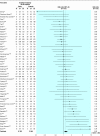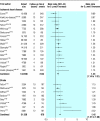Homocysteine and cardiovascular disease: evidence on causality from a meta-analysis
- PMID: 12446535
- PMCID: PMC135491
- DOI: 10.1136/bmj.325.7374.1202
Homocysteine and cardiovascular disease: evidence on causality from a meta-analysis
Abstract
Objective: To assess whether the association of serum homocysteine concentration with ischaemic heart disease, deep vein thrombosis and pulmonary embolism, and stroke is causal and, if so, to quantify the effect of homocysteine reduction in preventing them.
Design: Meta-analyses of the above three diseases using (a) 72 studies in which the prevalence of a mutation in the MTHFR gene (which increases homocysteine) was determined in cases (n=16 849) and controls, and (b) 20 prospective studies (3820 participants) of serum homocysteine and disease risk.
Main outcome measures: Odds ratios of the three diseases for a 5 micromol/l increase in serum homocysteine concentration.
Results: There were significant associations between homocysteine and the three diseases. The odds ratios for a 5 micromol/l increase in serum homocysteine were, for ischaemic heart disease, 1.42 (95% confidence interval 1.11 to 1.84) in the genetic studies and 1.32 (1.19 to 1.45) in the prospective studies; for deep vein thrombosis with or without pulmonary embolism, 1.60 (1.15 to 2.22) in the genetic studies (there were no prospective studies); and, for stroke, 1.65 (0.66 to 4.13) in the genetic studies and 1.59 (1.29 to 1.96) in the prospective studies.
Conclusions: The genetic studies and the prospective studies do not share the same potential sources of error, but both yield similar highly significant results-strong evidence that the association between homocysteine and cardiovascular disease is causal. On this basis, lowering homocysteine concentrations by 3 micromol/l from current levels (achievable by increasing folic acid intake) would reduce the risk of ischaemic heart disease by 16% (11% to 20%), deep vein thrombosis by 25% (8% to 38%), and stroke by 24% (15% to 33%).
Figures



References
-
- Boushey CJ, Beresford SAA, Omenn GS, Motulsky AG. A quantitative assessment of plasma homocysteine as a risk factor for vascular disease. JAMA. 1995;274:1049–1057. - PubMed
-
- Danesh J, Lewington S. Plasma homocysteine and coronary heart disease. Systematic review of published epidemiological studies. J Cardiovasc Risk. 1998;5:229–292. - PubMed
-
- Eikelboom JW, Lonn E, Genest J, Hankey G, Yusuf S. Homocyst(e)ine and cardiovascular disease: a critical review of the epidemiological evidence. Ann Intern Med. 1999;131:363–375. - PubMed
-
- Cleophas TJ, Hornstra N, van Hoogstraten B, van der Meulen J. Homocysteine, a risk factor for coronary artery disease or not? A meta-analysis. J Am Coll Cardiol. 2000;86:1005–1009. - PubMed
Publication types
MeSH terms
Substances
LinkOut - more resources
Full Text Sources
Other Literature Sources
Medical
